Homer Hickam's Blog, page 2
November 8, 2020
Red and Pink Marked the Corridors of Death
Red and Pink Marked the Corridors of Death
In January, 1961, President John F. Kennedy came into office under full sails. He sounded good, looked good, and had the ability to connect with folks. He was charismatic, people just liked to get near him, and his big grin kind of lit up the room. As I wrote in Rocket Boys, I first came across Kennedy in Welch, our county seat, when he was trying to win the state primary against fellow Democrat Hubert Humphrey. It was necessary that he win our primary, so the press accounts went, because we disliked Catholics and if he could win in an awful state like West Virginia, he could win anywhere. This was, for most West Virginians, something of a surprise. We had no idea we were prejudiced against Catholics. I surely didn't know anybody who didn't like them. In fact, a high percentage of Coalwood folks were from Italy and Eastern Europe and were Catholics and we didn't think a thing about it. I understand now, of course, that even if it took inventing prejudice where it didn't exist and giving our entire state and its people a black eye in the process, the press didn't much care as long as they sold their newspapers.
But, anyway, there Kennedy was standing atop a limousine expounding on the benefits of food stamps which didn't yet exist, and how he was going to save coal miners from being poor. Since nearly all of the miners listening to him were fully employed and weren't hungry unless they happened to have skipped lunch that day, he wasn't making much headway with the crowd. That was until I asked him what he was going to do about space with a follow-on recommendation that we should go to the moon. When he said if he got to be President, maybe that's what we'd do, the crowd gave him a good cheer and I think it buoyed him a little bit. He won the West Virginia primary going away.
A freshman at Virginia Tech, I heard Kennedy's inaugural address on a radio in my room and liked what he had to say a lot. He promised we were going to fight tyranny, meaning the Communists in Russia and China, and also said that we should figure out what we could do for the country and not worry about what the country could do for us. Since I was in school to be an engineer to help beat the Russians in the space race and also intended to become an officer in the military, I figured I was right in line with President Kennedy's speech.
Looking back on it, I don't recall any of the cadets I knew caring two cents about politics. As far as we were concerned, the USA had grown as it should since 1776 during war and peace during which our country mostly did the right thing when it had to do it. Our history flowed from war to war and the country progressed westward and led the industrial revolution and that was all we needed to know. If we thought about modern history, it centered around the Cold War. Most of us thought, one way or the other, the tension between the United States and the Soviet Union would boil over and we might get caught up in it after we graduated but that was well into the future or so we thought. What we didn't know, while we were enjoying a crisp, beautiful Autumn in 1962, was there was something strange happening in Cuba that was about to bring the entire world to the brink and us with it.
These days, a lot of people make fun of the 1950's and 60's when grade school kids hid under their desks during atomic bomb drills. I mean how could a desk stop an atomic bomb? Haha. Well, not so fast. As it was explained to us by our teachers, it actually made some sense. We got under our desks to keep our little bodies from being sliced through by flying glass from shattered windows. That might not work but wasn't it worth a try? The fallout shelters that families built inside their homes back then are also thought of as pretty droll. Maybe so, but even if hiding out after the nukes dropped didn't work out, at least it showed parents cared enough about their children to prepare as much as they could. The point is most Americans thought back then that there was a real possibility that the Russians were going to hit us with atomic bombs and we'd hit them back. In other words, it was almost certain that we were all going to get blown up. Many a young man got his first successful sexual encounter in those days by reminding his young lady friend that they might as well spoon because they were probably going to die awful deaths, anyway. I mean that happened. A lot. Trust me.
In October my junior year at Virginia Tech, Premier Nikita Khrushchev of the Soviet Union noticed American Jupiter nuclear-tipped missiles were being installed in Turkey which was right next door to his country. Khrushchev was a commissar at Stalingrad, that horrific World War II battle, and had seen a lot of blood and guts and dying and killing. In comparison, Jack Kennedy was a lowly PT boat skipper in the South Pacific during that time, working in exactly the same setting as James Michener's novel Tales of the South Pacific. I also wrote about what really happened to Kennedy in The Ambassador's Son. Anyway, it wasn't Stalingrad. The Russian leader got it in his head that if that young upstart of an American President thought he was going to ring in his country with nuclear weapons, he'd return the favor by putting missiles in Cuba. Cuba was only 90 miles from Florida which meant our entire country east of the Mississippi was well within range. President Kennedy, getting wind of this, didn't take kindly to it and so the next thing I knew about it, I was with my cadet buddies huddled around our television sets in the day room listening to the President tell us that there was a very good chance that nukes were about to fly. Of course, he didn't say that directly but from the steel in his voice, and the phrases he used, it sounded a lot like an ultimatum and anybody who knew anything about our military knew there were atomic and hydrogen bombs already in the air aboard B-52s, just waiting out there somewhere over the Arctic ice to head to Russia. Likely, their bombers were also out there circling ready to go.
Toward the end of his speech, Kennedy gazed into the camera lens and with what I took as the utmost gravity said:
My fellow citizens, let no one doubt that this is a difficult and dangerous effort on which we have set out. No one can foresee precisely what course it will take or what costs or casualties will be incurred. Many months of sacrifice and self-discipline lie ahead -- months in which both our patience and our will will be tested...
"Months! Holy shit," somebody said. "We're going to war!"
"The Corps will be called up," somebody else said and nobody argued with that assessment although, privately, I think there were more than a few of us who suspected we would be radioactive dust long before that happened.
When I heard a professor who was an expert on radiation had agreed to talk to the Corps, I gathered with a crowd in the Burruss Hall auditorium. It was packed. I recall the sour smell of damp wool. We were sweating in our uniforms. The man, an older gentleman with a kindly face like somebody's favorite uncle, was dressed in a tweed jacket and soon had us mesmerized by his calm, matter-of-fact analysis of the horror that was coming.
On a flip chart, he showed the likely targets for the Soviets and his assessment of the size of the bombs they'd use. Cities with more than a million population or the District of Columbia were probably going to be hit with 100 megaton monsters. Smaller cities were going to get 50 megatons. Military bases would be pounded by the more surgical 25 tonners that would still leave craters ten miles in diameter. The closest military base to Blacksburg was Radford Arsenal, about twenty miles away. The good Professor said Radford would probably only get five or ten megatons. "Still," he went on, "we'll feel its effects here. If you're standing outside when it hits and looking in that direction, you'll first see a flash and then you will be completely, utterly blind. That will essentially be a death sentence. The heat will be close behind so, if you were lucky enough not to see the flash, I recommend you try to get behind something. The blast effect . . . well, it'll be like a hurricane. Buildings will come apart and debris will be flying everywhere with enough force to kill. Then will come the radiation but not just from Radford. From everywhere."
He flipped his chart to show the normal winds of October in the United States with red and pink swaths marking the likely path of fallout and radiation from an attack on the east coast. The only thing on his chart that I halfway liked was that Coalwood and, in fact, all of McDowell County did not fall within any of the radiation corridors. Maybe my folks would survive even if my brother and I didn't. But what kind of world would be left? The Professor wasn't hopeful. "There will be massive casualties," he said. "There won't be many doctors or nurses left and most of the hospitals will be rubble. It will be a nightmare where the living will envy the dead. Eventually, I suspect, most life in the northern hemisphere will die off. In the southern hemisphere, well . . . " He shrugged. "It depends on where the wind blows and the currents flow. Are there any questions?"
If there were any, I don't recall them. I slogged dismally back to Brodie Hall and joined the Squadron A cadets in front of the television in the day room. No one said anything. We just watched the constant news which really had nothing new to say. My text books were waiting in my room but I saw no good reason to study.
On October 27, the news came that one of our U-2 reconnaissance planes over Cuba had been shot down and the pilot killed. "Those damn Russians! Kill 'em all!" I heard a cadet yell down the hall. Much of America echoed that sentiment. Shortly afterwards, an American destroyer was reported to have depth-charged a Russian submarine. We began to see on television film of fallout shelters being prepared and troops on the move in Florida toward Key West to jump off to Cuba. Civil Defense made announcements with advice on what to do if war came, mainly to listen for the sirens and get to the shelters if you could find one. All that was left to the students at Virginia Tech was to do what we always did and that meant for the cadets, get up at oh six hundred in the morning to calls of "First Call to Growley, sir!" and march in formation to breakfast and then spend the day in class or the library or in our rooms studying and then evening formation and dinner in the mess hall and back to our rooms for more studying or going down to the day room to watch the television. For the most part, there were few smiles and none of the usual high jinks or pranks in the Corps. We just existed to wait to see if we would continue to exist.
It was hard to sleep. My old lady - as our room mates were called back then - in the lower bunk asked me what I was thinking. "Nothing, really," I told him which was true. I thought it was better not to dwell on it.
"You scared?"
I let my mind wander inward to see if I was. "No," I said, honestly. "Not yet."
"I am," he confessed.
It occurred to me that I was who I was. Coalwood boys mostly learned not to be scared. Our fathers disappeared every day down into a deep, dark coal mine and there was no guarantee they would come back up whole. That should have scared us every day but, after awhile, I guess we just got kind of numb to it. Still, this was different. There was a good chance the whole planet was about to die.
A week after Kennedy's speech, without any specifics, it was announced that the Russians had agreed to withdraw their missiles and the American blockade was lifted. As the years passed, we would learn that we came very close to an exchange of nukes because of miscalculations on both sides. To this day, if you read most American historians, they will claim that it was Khrushchev who blinked and gave in. A deeper unpeeling of that onion shows very clearly both he and Kennedy blinked. With the big news operations in the United States in collusion with the Kennedy Administration to make it look like we won, the removal of the Soviet missiles was celebrated while the quiet removal of our Jupiter missiles from Turkey went mostly unreported.
In the Virginia Tech barracks and dormitories and classrooms and cafeterias and mess halls, as yet we students knew nothing of that and some never would for, all too soon, they were to be bloody sacrifices to a proxy war in Vietnam. Instead, we tried not to look or act as relieved as we felt.
For a while, at least, we slept the sleep of the saved.
<!-- /* Font Definitions */ @font-face {font-family:"New York"; panose-1:2 11 6 4 2 2 2 2 2 4; mso-font-alt:Tahoma; mso-font-charset:0; mso-generic-font-family:roman; mso-font-pitch:variable; mso-font-signature:3 0 0 0 1 0;} @font-face {font-family:"Cambria Math"; panose-1:2 4 5 3 5 4 6 3 2 4; mso-font-charset:0; mso-generic-font-family:roman; mso-font-pitch:variable; mso-font-signature:-536870145 1107305727 0 0 415 0;} @font-face {font-family:Georgia; panose-1:2 4 5 2 5 4 5 2 3 3; mso-font-charset:0; mso-generic-font-family:roman; mso-font-pitch:variable; mso-font-signature:647 0 0 0 159 0;} /* Style Definitions */ p.MsoNormal, li.MsoNormal, div.MsoNormal {mso-style-unhide:no; mso-style-qformat:yes; mso-style-parent:""; margin:0in; margin-bottom:.0001pt; mso-pagination:widow-orphan; font-size:12.0pt; mso-bidi-font-size:10.0pt; font-family:"New York",serif; mso-fareast-font-family:"Times New Roman"; mso-bidi-font-family:"Times New Roman";} .MsoChpDefault {mso-style-type:export-only; mso-default-props:yes; font-size:10.0pt; mso-ansi-font-size:10.0pt; mso-bidi-font-size:10.0pt;}size:8.5in 11.0in; margin:1.0in 1.0in 1.0in 1.0in; mso-header-margin:.5in; mso-footer-margin:.5in; mso-paper-source:0;} div.WordSection1 {page:WordSection1;}</style></p>
October 3, 2020
Treatment of The Coalwood Rocket Boys: A Proposed TV Series
Note: This is a recent pitch or treatment of a proposed television series based on The Coalwood Way, the "equal" to my original memoir Rocket Boys/October Sky.
THE COALWOOD ROCKET BOYS
The Television Series
BASED ON A TRUE STORY
A television series is proposed based on the New York Times best-selling book THE COALWOOD WAY (Delacorte Press; First Edition edition (October 10, 2000), ISBN-10: 0385335164, ISBN-13: 978-0385335164) and the short stories of Homer Hickam about his days as a Coalwood Rocket Boy.
The series is set in Coalwood, West Virginia, a miner's town built to fit within a narrow valley surrounded by high, heavily forested ridges. Every house, fence, road, store, and church is owned by the coal company. Every man works for the mine. All the women who live in the town, except teachers, are wives of the coal miners. All the kids are the children of these coal mining families.
The episodes begin in the fall of 1958, a time of harsh economic recession for the coalfields of West Virginia, and the beginning of the space age in the outside world. Each show will draw from the rich lode of stories about the strong, proud, and rambunctious people of Coalwood struggling with the realization that their little town may be dying, and that their children are being torn between following the old life of their parents or choosing what appears to be a bright new future in the outside world. Across generational lines, a town begins to fight a war over its children, and a mother and father enter into a kind of bloodless combat over the fate of their sons.
Because of its unique setting, The Coalwood Rocket Boys will break new ground and will attract young and mature viewers alike, the shows spotlighting adults and teen-agers in turn. There are also many possibilities for comedic episodes, the book often cited for its ability to make the reader laugh and cry, sometimes on the same page.
From his room, teenager Homer H. (Sonny) Hickam, Jr., the main character (and often the narrator) can see the coal mine tipple, the black steel tower that lowers and lifts the miners' cage. The town is governed by the rhythms of the shifts at the mine. Sonny Hickam is a Coalwood boy, destined, it seems, to eventually join the miners digging coal until he decides to build rockets and someday go to work for NASA. He recruits his friends to join him in what he calls the Big Creek Missile Agency (named after Big Creek High School). Now, suddenly, Sonny and his friends, Quentin, Roy Lee, and O'Dellbegin to look in an entirely different direction from their fathers -- up. Their determinedly optimistic plan to build rockets is set against a town beset with economic problems. Quentin is the prototypical nerd, Roy Lee is the most mature of the boy (he has a car and a girl friend!), and O'Dell is the scrounger of rocket supplies, always with a scheme.
The book, the inspiration for the episodes, has tales of not only rocket-building, but of loves won and lost, of family struggles between father, mother, sons, and daughters coping with great change, of high-spirited school classes and dances, of dealing with teenage bullies, of hard-working men in the mine, of gossip, of church-going, of preachers and prostitutes, of grand drama across a little town fighting a losing battle to survive.
Besides Sonny Hickam and the Rocket Boys, the main characters include:
Homer Hickam, Sr., Sonny's father and the superintendent of the coal mines in Coalwood. Self-educated and well-read but lacking the formal engineering education usually required for the job, he devotes all of his energies to keeping the mines productive for its owners and safe for the men who work inside. Homer is tough and disciplined and the heart of the little town. He is certain about every thing he does and thinks, including the probability that his dreamer second son, Sonny, is never going to amount to much. He dotes on Jim, his football star son because Homer once wanted to be a football star, too. Despite his hard manner, he has a softer, gentler side to him, especially for his wife, Elsie. We also see him grow to have a new respect for Sonny as the rockets of the Big Creek Missile Agency get more and more sophisticated and start to reach for extreme altitudes.
Elsie Hickam, Sonny's mom and Homer's wife, an independent woman ahead of her time and the only person in the town who can stand up to her husband. Despite her independence, Elsie Hickam leads a lonely life with a man whose first love is the coal mines. She is also determined that her sons will not follow in her husband's footsteps into the mine. She is seen over the years painting a scene on the wall of her kitchen, a picture of a beach where she hopes someday to live.
Jim Hickam, Sonny's brother, a handsome, girl-crazy high school football star struggling with his own sense of inadequacy by pretending bravado that often isn't there as he contemplates having to compete in the outside world and dreams of a football scholarship. He is outwardly disdainful of his younger brother but is mostly bemused by Sonny's energetic optimism.
Valentine Carmina, a gorgeous, sensual young woman who is nearly always in trouble with the high school principal and the managers of the coal mine. Sonny is attracted to her although she is from one of the poorest families in Coalwood and is not considered his social equal. Valentine returns Sonny's interest but doesn't share his dreams of space. She has her eye on escaping Coalwood and its restrictive ways by becoming an actress. She organizes a local theater group but runs into opposition from the coal company and the company church.
Jake Mosby, a young mining engineer, an outsider sent by the company owners to Coalwood for "seasoning." Jake is a great lady's man, owns a bright red Corvette, is a Korean War veteran (flew jets), drinks a little too much, and represents to the boys the wonderful outside world. Always a little in trouble with the coal company, he is somewhat inept as an engineer but is socially smooth, adored by the all the women in town (some mother him, others lust after him), Jake provides a kind of touchstone for the outside world for Sonny and the boys, often giving bad advice but coming through in the end to resolve problems both for himself and others in Coalwood.
Freida Riley, a twenty-one year old, bright and beautiful high school chemistry and physics teacher, who acts as the boys' mentor. She has Hodgkin's disease in remission. She and Jake Mosby have something going on between them, off and on. Besides trying to help the boys in a somewhat repressive school environment, she also has to cope with an almost assured death sentence from her insidious cancer.
The Reverend "Little" Richard, the black preacher in town who provides wit and wisdom to Sonny. Richard always has a Bible quote, story, or parable handy to guide the young man along the way. Richard must also act as the representative of the black community to the company. Black men work side by side with whites in the mine. All are black when they come out of the mine. All consider themselves proud Coalwood citizens. Yet, black housing is in a separate part of town, thus artificially dividing the people.
Lesser characters include, Reverend Lanier, the white preacher in town, Mr. Dantzler, the company store manager, Mr. Turner, the high school principal, Geneva Eggers, the town prostitute (she lives in a cabin high on a mountain), John Eye, the town bootlegger, Bill Bolt, the machinist who helps build the rockets for the boys, Tag Farmer, the town constable, and Mr. Dubonnet, the union chief (and a high school boyfriend of Elsie Hickam).
And so the drama for the series is established. As the Rocket Boys build their rockets, the town is changing, the people worried, the mine struggling. Yet these are a proud people who will work to keep their little town intact.
Some suggested episodes:
(1) Cape Coalwood: The boys' rocket range is an old coal slack dump three miles out of town. Elsie visits it during a rocket launch and discovers Coalwood citizens want to watch the boys launch their rockets but are hampered by the rutted, dirt road to "Cape Coalwood." She begins to use her time-tested ways to harass her husband into doing what she wants him to do and that, for the Rocket Boys, is to improve the road. She has the preacher preach a sermon about it, she "forgets" to cook supper, she takes Chipper, her pet squirrel (who Homer hates) to sleep on her pillow, and paints Homer out of the kitchen mural of Myrtle Beach. A secondary story has Sonny and Roy Lee trying to help Valentine stage her play. Since no one will allow her to have it either at a school or the church, she has decided to have it outdoors. For that she needs a place. Why not Cape Coalwood?
(2) The Strike: The miners go out on strike. Sonny ends up being in the middle of everything when he convinces Bill Bolt to sneak in at night to help build his rockets. Homer is proud of Sonny's initiative but must punish him and Bill, making the strike even more bitter. Elsie confronts Homer when the other wives stop talking to her and Sonny's classmates shun him because of who his father is. Mr. Dubonnet offers to end the strike for Elsie. Elsie is torn between two men, her husband who she loves, and Dubonnet who she once loved. Sonny must go to his father and take responsibility for the trouble. Little Richard counsels Sonny to have courage like Dan'l in the lion's den. A secondary story has Freida Riley and Jake Mosby confronting the fact that Jake isn't mature enough to stop his womanizing and commit to Freida. Freida knows that she has a harsh choice: accept Jake for what he is and continue to love him, or walk away.
(3) The Woman's Club: Elsie demands that the railroad tracks be removed from Coalwood after she observes the coal dust from the open cars covering a new-born baby. She organizes the coal company woman's club to lead a protest. Sonny accidentally gets trapped in a coal car, taking a dangerous ride. This not only gets Sonny in big trouble with his father but also gives Elsie and the woman's club fresh reason to have the tracks removed. A secondary story involves brother Jim and a girl friend who, desperate to escape her family, wants to get married. Hoping to get pregnant, she tries to seduce him. Jim is tempted but hesitates. Valentine tells Sonny of the girl's plan. Jim refuses to believe Sonny's warning. Sonny goes to Reverend Richard with Jim's problem. He tells him the story of Samson and Delilah and Sonny sets out to convince Jim that the girl will sap his strength before the big game, thus ruining any hope he may have for a football scholarship.
(4) The Truth of Miss Geneva: Geneva Eggers, the town prostitute, becomes the target of Reverend Lanier who is trying to increase church attendance. Homer (Dad) saved Geneva as a child from a burning house and has secretly protected her ever since. He must somehow continue to protect her while keeping the church-goers happy. Sonny is seen sneaking into Geneva's house. He's there to ask her to let him put up a wind gauge on her cabin so he can judge the wind velocity before his rocket launches but everybody jumps to the wrong conclusion, including Elsie. A secondary story has Reverend Richard and Reverend Lanier arguing conflicting philosophies. Reverend Richard challenges Reverend Lanier to trade churches for one Sunday to see who's the better preacher. Richard's style is singing and boisterous preaching. Reverend Lanier is a much more intellectual approach. The two congregations confront the two different styles with humorous results.
(5) Jake's Mind: A miner is killed in the mine and everybody believes that Jake Mosby's sloppy engineering caused it, including Jake. Freida defends Jake, even to himself. Homer (Dad) investigates. Jake helps Sonny and the boys with their rockets, trying to remember why he ever became an engineer in the first place. A secondary story has Valentine sent home from school for wearing, as Mr. Turner calls them, "Jezebel" clothes. When she discovers that Valentine has never been properly taught about clothes (she has been raised by her widower father), Elsie decides to take the girl shopping in Welch, the county seat.
(6) Superstition: Miss Riley receives no new lab equipment in her classroom. She resolves to teach the boys chemistry and physics by demonstration in the real world. She asks Homer (Dad) to take her class into the coal mine. He is appalled. It's bad luck for women and girls to go in the mine. Still, he's tempted. He wants Sonny to someday be an engineer in the mine. John Dubonnet, the union chief, talks to Elsie, making Homer jealous. Homer resolves to do what the union is against: agreeing to Miss Riley's request. The whole town is in turmoil as a result and it is up to Elsie and Sonny to figure out a way of getting Homer (Dad) out of the mess. A secondary story involves Sonny and the boys deciding to use a potentially dangerous new propellant. Quentin and Sonny begin a series of experiments in the basement, resulting in blowing up the Hickams' hot water heater. Now, they have to replace it, somehow. O'Dell proposes selling ginseng but first they have to find some and dig it up. It turns out the best crop is on Geneva Eggers' property, a place the boys have been ordered to never go.
(7) Tropic of Coalwood: A copy of Tropic of Cancer is found in Quentin's briefcase. In an attempt to get the boy too worn out to think about sex, Quentin, the prototypical nerd, is ordered by Mr. Turner to join the football team. All the rocket boys join with him with predictable and hilarious results. In a moment of insanity, the rocket boys tell the Big Creek "front four" that the cheerleaders would rather go with them to the Prom than the players. A bet is made. Now, the rocket boys have to figure out how to get the cheerleaders on their side! They begin a fumbling, bumbling attempt to woo the more experienced and cagey girls to go with them. Valentine takes Sonny aside and explains girls to him. She takes it as a personal crusade to get Sonny a date with the head cheerleader. A secondary story has Elsie thinking about her high school days when she was Dubonnet's girl friend and Homer (Dad), somewhat of a nerd himself, was trying to win her over.
(8) Is that Rocket Fuel or What?: Homer orders Tag, the constable, to close down John Eye, the bootlegger, after catching one of his miners with moonshine down in the mine. The trouble is John Eye provides the boys their rocket fuel - pure alcohol! His place is also one of the social centers in town. Tag lays it on Sonny - he's going to shut down John Eye unless Sonny can somehow convince his father otherwise. Sonny goes to Reverend Richard who goes to Homer and reminds him that John Eye is protected by a promise made my Homer's mentor, The Captain, just before he died. Seems John Eye saved The Captain's life. Homer is caught between his order and The Captain's old promise. He struggles for a compromise.
(9) Beware yon Dubonnet, with the lean and hungry look: Valentine puts on another stage production, a revised version of Julius Caesar, which makes fun of the coal company, the football team, the union, and even the woman's club (Elsie is president). Not only is that going to cause trouble all by itself, Sonny wrote it! After the show, he is in serious trouble with just about everybody in town. He decides to concentrate on rockets, not writing, but Freida Riley urges him to keep going on both. A secondary story has Mr. Dantzler, the company store manager, trying to sell television sets in a town set a valley too deep to receive TV signals. Quentin comes up with a plan to establish a cable system by erecting an antenna on a high mountain. The best place for the antenna is Geneva Eggers' property, owned by her and not the coal company. The company tries to make a land grab.
<!-- /* Font Definitions */ @font-face {font-family:Courier; panose-1:2 0 5 0 0 0 0 0 0 0; mso-font-charset:0; mso-generic-font-family:auto; mso-font-pitch:variable; mso-font-signature:3 0 0 0 3 0;} @font-face {font-family:"New York"; panose-1:2 11 6 4 2 2 2 2 2 4; mso-font-alt:Tahoma; mso-font-charset:0; mso-generic-font-family:roman; mso-font-pitch:variable; mso-font-signature:3 0 0 0 1 0;} @font-face {font-family:"Cambria Math"; panose-1:2 4 5 3 5 4 6 3 2 4; mso-font-charset:0; mso-generic-font-family:roman; mso-font-pitch:variable; mso-font-signature:-536870145 1107305727 0 0 415 0;} @font-face {font-family:Times; panose-1:2 0 5 0 0 0 0 0 0 0; mso-font-charset:0; mso-generic-font-family:auto; mso-font-pitch:variable; mso-font-signature:-536870145 1342185562 0 0 415 0;} /* Style Definitions */ p.MsoNormal, li.MsoNormal, div.MsoNormal {mso-style-unhide:no; mso-style-qformat:yes; mso-style-parent:""; margin:0in; margin-bottom:.0001pt; mso-pagination:widow-orphan; font-size:12.0pt; mso-bidi-font-size:10.0pt; font-family:Courier; mso-fareast-font-family:"Times New Roman"; mso-bidi-font-family:Times;} p.MsoHeader, li.MsoHeader, div.MsoHeader {mso-style-unhide:no; mso-style-link:"Header Char"; margin:0in; margin-bottom:.0001pt; mso-pagination:widow-orphan; tab-stops:center 3.0in right 6.0in; font-size:12.0pt; mso-bidi-font-size:10.0pt; font-family:Courier; mso-fareast-font-family:"Times New Roman"; mso-bidi-font-family:Times;} p.MsoFooter, li.MsoFooter, div.MsoFooter {mso-style-unhide:no; mso-style-link:"Footer Char"; margin:0in; margin-bottom:.0001pt; mso-pagination:widow-orphan; tab-stops:center 3.0in right 6.0in; font-size:12.0pt; mso-bidi-font-size:10.0pt; font-family:Courier; mso-fareast-font-family:"Times New Roman"; mso-bidi-font-family:Times;} span.FooterChar {mso-style-name:"Footer Char"; mso-style-unhide:no; mso-style-locked:yes; mso-style-link:Footer; mso-ansi-font-size:12.0pt; font-family:Courier; mso-ascii-font-family:Courier; mso-hansi-font-family:Courier;} span.HeaderChar {mso-style-name:"Header Char"; mso-style-unhide:no; mso-style-locked:yes; mso-style-link:Header; mso-ansi-font-size:12.0pt; font-family:Courier; mso-ascii-font-family:Courier; mso-hansi-font-family:Courier;} .MsoChpDefault {mso-style-type:export-only; mso-default-props:yes; font-size:10.0pt; mso-ansi-font-size:10.0pt; mso-bidi-font-size:10.0pt; font-family:"New York",serif; mso-ascii-font-family:"New York"; mso-hansi-font-family:"New York"; mso-bidi-font-family:Times;}size:8.5in 11.0in; margin:1.0in 1.25in 1.0in 1.25in; mso-header-margin:.5in; mso-footer-margin:.5in; mso-paper-source:0;} div.WordSection1 {page:WordSection1;}</style></p>
June 22, 2020
The Dinosaur Wars and Understanding Cause and Effect
I've always been interested in cause and effect in my writing and life in general. For instance, during my years of hunting dinosaurs, I noticed a competition between American paleontologists that seemed pretty intense and wondered what caused it. After all, I'm not a professional bone-hunter in any sense, only a fellow who likes to dream about the past and the future, and is willing to get my hands dirty to get involved. After doing my due diligent research, I began to understand that paleontologists are competitive for the reasons most of us are. They need funding to do what they do, they want to influence others to think the way they do about their field of study, and they simply want to be appreciated for the hard work they accomplish in difficult conditions. But I think this competition may also be an echo of the so-called dinosaur wars in the American west in the late nineteenth century. That was when Dr. Edward Drinker Cope and Dr. Othneil Marsh, two of the most famous and influential dinosaur hunters of that age, started an unofficial war. But, as often happens in research, my study of that war led me in an unexpected direction, to unravel another war that was happening at the same time. This war marked the end of a way of life for tens of thousands of indigenous people, the Sioux, the Blackfeet, the Crow, and several other smaller tribes known in general as the Plains Indians. Ironically, people from Europe were responsible for first creating and then destroying the civilization that took root in the plains of the American West. The Spanish inadvertently began the formation of this society by introducing horses to the Americas. When some of the horses escaped and made their way north from Mexico, various groups of indigenous natives, then hunter/gatherers and farmers, began to make use of them by following on horseback the vast buffalo herds that were then roaming central North America. This new ability to keep up with the herds provided enough consistent food and materials to support increasing numbers of people that ultimately formed into communities we now call tribes. Before long, these tribes formed a unique civilization of mobile and competing groups that depended on the ready availability of the American bison on a sea of grass with no obvious borders. These requirements were so precise and critical that any interference from the outside had a good chance of causing the entire civilization to come crashing down and that's what ultimately happened. After the Civil War, there came to the western plains an assortment of men from the east, not a few of them hooligans of the worst stripe with a familiarity with guns and a disposition to use them. The railroads were happy to hire them to lay their tracks across the plains and to bully anyone who got in their way which definitely included the odd nomadic people they encountered. From the perspective of these rough men, the Plains Indians were people who wandered aimlessly and mostly got in the way. From the perspective of the tribal leaders and young warriors, their lands were being invaded by gangsters who were inclined to indiscriminately kill the buffalo, steal their women, disrespect their leaders, and damage their way of life. Alcohol, vast quantities of which was brought in and made readily available to hooligans and warriors alike, didn't help. Bullets and arrows started to fly. Behind the first bands of lawless adventurers came men with families who had no wish to fight with anybody. They only wanted to build homes, string fences, raise cattle, and put the land under the plow. Their efforts, seemingly benign, proved to be far worse for the Indians than the hooligans. Barbed wire kept the buffalo herds from moving on to fresh grass and caused the animals to go hungry. The introduction of cattle brought disease. Starving and sick buffalo equaled starving and sick tribespeople who, in reprisal, stole from the farmers and ranchers or attacked their settlements. Reluctantly responding after repeated demands from the settlers for help, the federal government finally dispatched the army to keep the peace. Army generals without any specific orders except stop the turmoil surveyed the situation and decided what needed to be done to get control of the situation was force the various tribes into small, isolated areas, wipe out the buffalo herds, and put the warriors afoot by taking away their horses. Before long, the battles and massacres known as the Indian Wars began and raged across the places where, coincidentally, amazing dinosaur bones were just being found. At first, it was the adventurers looking to make some easy saloon money who packed up old bones and shipped them east for anybody who would pay for them. Without knowledge of what they were doing, most of these samples arrived in poor condition but they were enough to intrigue both government and private scientific and educational establishments as to the potential of making some exciting and important discoveries. Heedless of the battles being waged between the Army and the tribes, they dispatched scientists with teams of men to secure the bone beds and dig up the best ones they could find. Among the bone-hunters heading to the plains was a young and wealthy paleontologist, the aforementioned Edward Drinker Cope. Cope was brilliant but unendowed with virtually anything in the way of social graces. He was slovenly, dominated every conversation without letting anyone get in a word, and seemed to lack the slightest ability to relate to another human being. Ostensibly representing the United States Geological Survey but accompanied by his own hired men who quickly learned he was in no way their friend but their boss, Cope roamed across the western battlefields passing without care or comment wandering bands of stunned and hungry tribespeople, huge mounds of rotting buffalo carcasses left by buffalo hunters or felled by disease, and a reckless United States Cavalry galloping around and chasing any Indians they saw. Cope's collecting in the Bridger Basin of Wyoming brought him into contact with another paleontologist, one Dr. Othneil Marsh of Yale University who considered that area his own private hunting ground. Marsh was an arrogant skinflint who often forgot to pay the salaries of his assistants and had the reputation of taking credit for discoveries made by others. To Marsh, Cope was an arrogant upstart and, after they met and Cope did not give Marsh his due deference, which was actually impossible considering the kind of man he was, their private war began. To marginalize Cope who did not have as much money or backing, Marsh flooded the bone hunting grounds with squads of diggers and collectors who filled hundreds of freight cars with bones that were shipped to New Haven for his exclusive study. He also traveled to the West to see things for himself. As if in a self-contained protective bubble, Marsh ignored the running battles replete with tootling bugles and war cries and wailing women and crying children and went wherever he pleased. His crews dug huge quarries that turned into mud holes where buffalo, deer, and elk got stuck and drowned, and dynamited sites coveted by the tribes for their seasonal villages. The Indians simply had no idea what to make of either Cope or Marsh except they were both probably crazy and bad luck to kill so they left them alone. While the bloody battles (which included Custer's Last Stand) continued between the cavalrymen and warriors, Cope and Marsh kept fighting their private war. When their men encountered each other in saloons, they fought with bare knuckles. In the field, they took pot shots at each other. When they got the opportunity, they jumped the others' claims and even dynamited the others' digs. On the academic front, the two paleontologists named new dinosaur species willy-nilly often based on the smallest of fragments, and generally did their best to discredit one another. In the process, Cope and Marsh caused not only damage to Cretaceous and Jurassic fossil beds but dinosaur science itself by creating a tortured mess of overlapping and, in some cases, nonexistent species that would take decades for modern paleontologists to unravel which still hasn’t completely been accomplished if it ever will. Eventually, karmic forces being what they are, Cope would die alone in a house filled with old bones while Marsh, broke and bitter, would pass on a couple of years later. Unfortunately, although they were gone, their battles had set the example amongst American fossil-hunters as to who named what, who was most deserving of grants, and also who among them would rise to the top of the paleontology heap. Although not as intense, this competition continues to this day.
To be a good novelist or memoirist, a writer much try to understand everything that causes people to do what they do, where their influences come from, and the spirits that flit around them, mostly unseen but surely felt. Those writers who don't peel back life to understand what's underneath it, or research the connections between their characters and the past of the places where they live, tend to write stories that readers sense are missing something.
When I decided to write a novel about modern paleontology, the result was my book titled The Dinosaur Hunter. In that story of intrigue and murder, the paleontologist that shows up on a remote Montana ranch looking for bones was undoubtedly influenced by the history of Cope and Marsh, a history that I left out of the novel since there was no place for it. Still, I knew about it and it changed the way I saw that fellow and wrote about him and what he did which I think made him feel more real to my readers. Hemingway was a proponent of this, by the way, in that he said (and I'm paraphrasing) it isn't necessary to include everything you know in a story because the reader will sense that you know it. The land itself, a harsh, remote place that holds the tough remnant of the people who followed the gunslingers, also holds the ghosts of the nomadic tribes of lost dreams and crushed souls. Such is history, such is life, such are the connections between us all for good or bad that the writer must strive to discover.
The Dinosaur Wars
June 10, 2020
How I Became A Dinosaur Hunter
 Little Sonny Hickam (him being me as a boy), about the time
Little Sonny Hickam (him being me as a boy), about the time
he started sifting through Coalwood's fossils
When I was a boy in the little mining town of Coalwood, West Virginia, I became aware of a huge dump of rejected coal that was also the repository of vast quantities of fossils. Fascinated and mystified, I often went there to peel away slabs of coal to reveal strange, tropical plants. Coalwood was a place where there were heavy snows in the winter so that didn't make a lot of sense. It was as if these remnants were from a different world and, in a way, they were. The era that produced the fossils inside the coal that my boyhood hands opened like pages of an ancient book was called the Carboniferous Period, a weird but extremely productive time for life on Earth. Because the world was warmer and wetter and its atmosphere contained much more carbon dioxide than today, our planet was essentially a greenhouse where plants grew without restraint. This went on for about six hundred thousand centuries until plants completely engulfed what was then a single continent we now refer to as Pangea. From space, had there been anyone up there to observe our world, it would have looked like a huge bright green lily pad floating on a dazzling blue sea, an ocean that was filled to the brim with creatures from single cells to complex organisms, most of them feeding on the detritus washed into it from the overgrown land.
 Carboniferous Era - Hot, muggy, lots of oxygen and carbon dioxide
Carboniferous Era - Hot, muggy, lots of oxygen and carbon dioxideto help plants grow and ready, given 300 million years or so, to turn itself into coal
So much carbon was ingested by the plants that flooded across the planet, the percentage of oxygen in the atmosphere rose to almost twice what it is today. The fires caused by lightning must have been spectacular. Eventually, huge mats of dead plants and ashes clogged all the major waterways. This phenomenon created vast deserts which caused the extinction of many species of reptiles, amphibians, fish, and insects. It was a great incongruity. An overabundance of life made remorseless death spread across the Earth. It also eventually created the layers of coal that lay in thick seams beneath my home town. As my boyhood self pondered the impressions of these old plants, I often wondered if I would find a dinosaur. Later in my education, I would learn that the Carboniferous age occurred well before they existed but the old dump had still started something in my head, an interest in all that had come before and how life had changed over time. After I became a scuba diver, this curiosity led me to explore caverns in Florida where I'd been told bones from extinct cave bears existed and, in a deep dive down a funnel of rock, I found a complete skeleton. When I ventured off to Honduras to map the reefs on the "lost" island of Guanaja, I climbed into its mountainous terrain and found pottery shards and decorative items created by the Payan people (akin to the Maya). These discoveries, along with books about ages past, somewhat satisfied my itch to understand prehistory but I never forgot about those days when I sat on a coal dump and wished I could find a dinosaur.
 This book changed the way millions looked at dinosaurs AND Paleontology
This book changed the way millions looked at dinosaurs AND Paleontology
When the novel Jurassic Park was published, like millions of other readers, I devoured Michael Crichton's story. Although it was an obviously fictional tale, it included information about the new science behind dinosaurs that theorized they were much more active and a lot different than we had been led to believe. After the movie came out and I saw the actor-paleontologists digging them up, I started thinking again how amazing it would be to find a dinosaur fossil although I had no real idea how to do it and, my writing career just taking off, was too busy to take the time to find out. It was just something I'd always kind of wanted to do but probably never would.
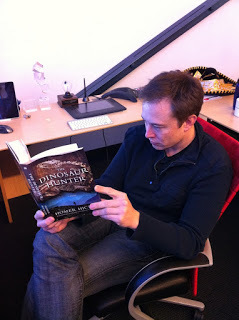 M
e reading Jurassic Park. Oh, wait, that's Elon reading my
M
e reading Jurassic Park. Oh, wait, that's Elon reading mynovel The Dinosaur Hunter. Never mind... Enter the force I think of as Kismet, the strange and curious destiny that seems to control my life. To my way of thinking, this ancient proposition is something greater than having a predetermined fate. It is a power outside of ourselves that somehow recognizes that which we need and opens a path that we may choose to follow or not. If chosen, it allows a life to not just be led but savored. The trick, however, is recognizing Kismet when it arrives and then having the will to follow it along passages that may not be easy and may, in fact, be very hard. Such was the path that opened for me to become a dinosaur hunter. My connection to the film Jurassic Park was that it happened to star Laura Dern who played the part of a paleontologist. A few years later, Ms. Dern also played my teacher Miss Riley in October Sky, the film based on my memoir Rocket Boys. When she and I attended the Venice Film Festival for the showing of October Sky, we talked mostly about Jurassic Park. She told me she loved working on the movie but confessed she hadn't actually visited a real dinosaur dig and didn't recall meeting any real dinosaur hunters or paleontologists. She couldn't help me find a dinosaur fossil but she said, "You know what, Homer, I bet you'll find one if that's what you want to do. Don't ask me how I know, I just do."
 October Sky movie poster - That's
October Sky movie poster - That'sLaura Dern on the right. On the left is
that other guy as older Sonny (Homer) when he no longer played on a coal dump
to look for fossils but launched rockets, instead And so it was because of Laura Dern in association with that Kismet thing that found me and my wife Linda one bright California morning sitting in the kitchen of Joe Johnston, the director of October Sky who, in a lull in the conversation, said to me, "Homer, I was talking to Laura Dern the other day and she said she thought you might be interested in what I've been doing." Joe left the kitchen and soon returned with a cigar box filled with rough yellowish fragments, the biggest of which was perhaps only several inches wide. "Dinosaur bones," he said and went on to explain that he'd picked them up while scouting locations for his next movie which was to be the third in the Jurassic Park series titled, appropriately enough, Jurassic Park III.
 Dinosaur bone chips called "Float" like Joe Johnston showed me
At the sight of the dusty bone chunks within the cigar box, I found myself unaccountably thrilled. "Where did you find these?" I asked, taking the box from Joe. "Montana," Joe said and reached to take the bones back. I pulled the box away and my interrogation continued. "Where in Montana?" "Well, we start in Bozeman but you probably don't know where that is." "Oh, but I do!" It was even the truth. My wife Linda and I had friends in Bozeman, a fine couple named Frank and Naomi Stewart. We regularly visited them every winter to go skiing. All of a sudden, I was that boy sitting on a coal dump peeling open slabs of coal looking for dinosaurs. "Joe, the next time you go out there, can I go with you?" Joe smiled. "Sorry, Homer. We're done scouting." I couldn't let it go. "If you'll tell me where you were," I proposed, "maybe I could go there and look around?" "You can't just pick up dinosaur bones,” Joe explained. He was now frowning. “You have to go with somebody who knows what he's doing." "Who did you go with?" I asked. "Dr. Horner is his name," Joe answered, "but he doesn't let just anybody go out with him. I only got to go because we hired him to be an advisor on our movie." The bones in the box had cast a spell over me. "But if you asked him,” I pressed, “do you think he'd let me go with him?" This time, Joe managed to wrest the box out of my hands and carried it back from whence it came. While he was out of the room, Linda brought up some facts for my due consideration. "Homer, you can't go to Montana. You've got speeches scheduled nearly every week for the rest of the year and have you forgotten your book deadline?" I hadn't forgotten. After all, I was already on chapter two and I had months (well, ok, one) to get it done but I could already feel that I not only wanted to but needed to take that Coalwood boy I once was and find, as I always wanted to do whether I knew it or not, dinosaur bones in Montana. When Joe returned, I kept pressing him until he said that maybe he could find out if I could go with Dr. Horner at some unspecified time in the undetermined future. Recognizing that was as far as he was willing to go, I finally fell silent about the matter and our visit was done. On the way to the airport, I reflected that maybe I was just being silly. What was the big deal about finding dinosaurs, anyway? When we got home, I got back to working on the book manuscript but, when I looked up from my computer or was out running, I still couldn’t shake the idea of going out to Montana and looking for ancient bones. To that end, I kept sending Joe occasional emails, asking him to please ask Dr. Horner on my behalf. He never answered until, to my astonishment, he surprised me with a call. Dr. Horner had given me permission to visit his summer camp near Fort Peck Reservoir in northeast Montana. My response, after a thank you, was, "How about Frank?" "Who?" "Frank Stewart, my buddy in Bozeman." "Just you, Homer," he said and, after claiming he was busy which might have even been true, Joe Johnston hung up. I sat back in my chair and gave it some thought. After a few moments of mental gymnastics, I decided surely it would be OK to bring Frank along. If there was any objection, I could explain him away as my driver or something. A preacher back in Coalwood used to say, "When a door closes, the good Lord will open another one." My mom used to add, "If that doesn't work, Sonny boy, knock out a window and crawl through it."
Dinosaur bone chips called "Float" like Joe Johnston showed me
At the sight of the dusty bone chunks within the cigar box, I found myself unaccountably thrilled. "Where did you find these?" I asked, taking the box from Joe. "Montana," Joe said and reached to take the bones back. I pulled the box away and my interrogation continued. "Where in Montana?" "Well, we start in Bozeman but you probably don't know where that is." "Oh, but I do!" It was even the truth. My wife Linda and I had friends in Bozeman, a fine couple named Frank and Naomi Stewart. We regularly visited them every winter to go skiing. All of a sudden, I was that boy sitting on a coal dump peeling open slabs of coal looking for dinosaurs. "Joe, the next time you go out there, can I go with you?" Joe smiled. "Sorry, Homer. We're done scouting." I couldn't let it go. "If you'll tell me where you were," I proposed, "maybe I could go there and look around?" "You can't just pick up dinosaur bones,” Joe explained. He was now frowning. “You have to go with somebody who knows what he's doing." "Who did you go with?" I asked. "Dr. Horner is his name," Joe answered, "but he doesn't let just anybody go out with him. I only got to go because we hired him to be an advisor on our movie." The bones in the box had cast a spell over me. "But if you asked him,” I pressed, “do you think he'd let me go with him?" This time, Joe managed to wrest the box out of my hands and carried it back from whence it came. While he was out of the room, Linda brought up some facts for my due consideration. "Homer, you can't go to Montana. You've got speeches scheduled nearly every week for the rest of the year and have you forgotten your book deadline?" I hadn't forgotten. After all, I was already on chapter two and I had months (well, ok, one) to get it done but I could already feel that I not only wanted to but needed to take that Coalwood boy I once was and find, as I always wanted to do whether I knew it or not, dinosaur bones in Montana. When Joe returned, I kept pressing him until he said that maybe he could find out if I could go with Dr. Horner at some unspecified time in the undetermined future. Recognizing that was as far as he was willing to go, I finally fell silent about the matter and our visit was done. On the way to the airport, I reflected that maybe I was just being silly. What was the big deal about finding dinosaurs, anyway? When we got home, I got back to working on the book manuscript but, when I looked up from my computer or was out running, I still couldn’t shake the idea of going out to Montana and looking for ancient bones. To that end, I kept sending Joe occasional emails, asking him to please ask Dr. Horner on my behalf. He never answered until, to my astonishment, he surprised me with a call. Dr. Horner had given me permission to visit his summer camp near Fort Peck Reservoir in northeast Montana. My response, after a thank you, was, "How about Frank?" "Who?" "Frank Stewart, my buddy in Bozeman." "Just you, Homer," he said and, after claiming he was busy which might have even been true, Joe Johnston hung up. I sat back in my chair and gave it some thought. After a few moments of mental gymnastics, I decided surely it would be OK to bring Frank along. If there was any objection, I could explain him away as my driver or something. A preacher back in Coalwood used to say, "When a door closes, the good Lord will open another one." My mom used to add, "If that doesn't work, Sonny boy, knock out a window and crawl through it." The Dino Boys Caricature by
The Dino Boys Caricature bythe great Don Howard
 Frank and Homer - Dino Hunters
Frank and Homer - Dino Hunters
Since I was my mother's son, I subsequently dialed Frank's number. "Would you like to go with me to hunt dinosaurs?" I asked as soon as he picked up. "Sure," Frank said, and then, after a pause, "What was the question again?" And that's pretty much how Frank Stewart and I became true dinosaur hunters and also when I began my somewhat obsessive quest to find for myself not only dinosaur bones but, at the behest of one of the greatest paleontologists of them all, the remains of a young version of that ancient and entirely glorious but ultimately tragic creature known formally and majestically as Tyrannosaurus rex.
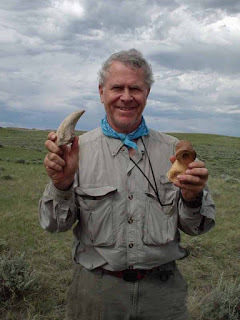 The Day I found my little T
The Day I found my little T
January 27, 2020
My Markup of Title II, Subtitle A, of HR 5666
My Markup of HR 5666*
* I focused entirely on Title II. I did not mention Mars because I think without building a permanently crewed Lunar Outpost that then becomes an anchor for gathering Lunar resources to provide wealth and security to the people who pay the bills - your poor working stiffs aka the American taxpayers - NASA will never send people to Mars because there would be a tax revolt. Once the Lunar Outposts are built and we are a true spacefaring nation where everybody is getting something out of it, the Mars crowd can then write their own damn HR's.
TITLE II—HUMAN SPACE EXPLORATION AND OPERATIONS Subtitle A—Permanently Crewed Lunar Outpost Program SEC. 201. SUSTAINABLE HUMAN EXPLORATION PROGRAM. It is the sense of Congress that the Nation’s human exploration program is an important element of United States leadership in space exploration, economic strength, and national security. It is the further sense of Congress that constancy of purpose and the sustainability of the Nation’s human exploration goals and objectives should be an inherent principle of a long-term human presence on the lunar surface that spans several Congresses and Administrations and provides for development of the moon, henceforth described as Luna in this document, for the economic benefit, security, and general welfare of the American people and the world at large. VerDate Mar 15 2010 15:26 Jan 22, 2020 Jkt 000000 PO 00000 Frm 00009 Fmt 6652 Sfmt 6201 C:\USERS\JWGROSS\APPDATA\ROAMING\SOFTQUAD\XMETAL\7.0\GEN\C\NASA_AUTH SEC. 202. GOALS AND OBJECTIVES. (a) IN GENERAL.—The Administrator is authorized under sections 20302 and 70504 of title 51, United States Code, and shall carry out plans and programs to achieve sustainable human presence on the surface of Luna. (b) ESTABLISHMENT.—The goal of NASA’s Permanently Crewed Lunar Outpost program shall be to land humans on Luna, first in 2024 by any means necessary, and next establish one or more sustainable permanently crewed outposts on the Lunar surface by 2030. (c) PRECURSOR ACTIVITIES.—The Administrator, as he may deem necessary, shall undertake precursor crewed and robotic missions to cis-lunar space and the lunar surface to determine the most efficient and safe methods of constructing permanently crewed lunar outposts.(d) OBJECTIVES.—The objective of our human missions to Luna will be, by 2030, to construct one or more permanently crewed lunar outposts as anchors to support commercial, scientific, and academic organizations intent on acquiring the resources & knowledge of the moon for the economic benefit, security, & general welfare of American citizens and, by extension, the citizens of the world. These outposts will provide, for a negotiated fee, the necessary living areas, sustenance, and hangar space required for such organizations to outfit and prepare themselves for their various missions, both scientific and commercial. As listed in Section 203 (g) below, International partners will be fully welcomed.
SEC. 203. STRUCTURE OF PERMANENT LUNAR OUTPOST PROGRAM.
(a) Permanently Crewed Lunar Outpost OFFICE.—The Administrator shall establish a Permanently Crewed Lunar Outpost Office within 60 days of the enactment of this Act to lead and manage the Permanently Crewed Lunar Outpost program. (b) PROGRAM DIRECTOR.—The Administrator shall appoint a Program Director of the Office established in subsection (a) who shall report to the Associate Administrator and the Associate Administrator of the Human Exploration and Operations Mission Directorate. (c) RESPONSIBILITIES.—The Permanently Crewed Lunar Outpost Program Office shall be responsible for developing—
(1) a schedule of flights and demonstrations on the Lunar surface that would support and lead to a permanently crewed lunar outpost by 2030 (2) inviting all interested academic, scientific, commercial, and International partners that may want to join our effort and determining the organization and investments that would result. VerDate Mar 15 2010 15:26 Jan 22, 2020 Jkt 000000 PO 00000 Frm 00011 Fmt 6652 Sfmt 6201 C:\USERS\JWGROSS\APPD (d) SYSTEMS ENGINEERING AND INTEGRATION.—
The Director of the Permanently Crewed Lunar Outpost Program shall appoint a Systems Engineering and Integration Manager to manage the systems engineering and integration activities of the program.
(e) SPECIAL HIRING AUTHORITIES.—The Administrator shall propose to Congress any special hiring authorities that the Administrator determines are needed to ensure that personnel with the requisite skills and experience are available to the Program Office.
(f) PROGRAM ELEMENTS.—The Permanently Crewed Lunar Outpost Program shall determine the best technical methodology for reaching the primary goal as listed in Sec. 202 Para. (d) above. It will keep the President, Congress, and the National Space Council fully apprised as to its progress toward the goal of establishing one or more fully operational Permanently Crewed Lunar Outposts by 2030. Progress reports will include:
(1) Within 30 days of the enactment of this act, the administrator will order an independent agency, with experience in spaceflight, finance, and statistical analysis, to determine if its present plans to land Americans on Luna by 2024 is feasible and, if not, to present an alternate plan.
(2) Within 120 days of the enactment of this act, the administrator will, in consultation with academic, government, scientific, and commercial entities, produce a report that lays out how one or more Permanent Lunar Outposts can be constructed for the purpose listed previously, and an annual outlay of funds required to implement this plan through 2030. This will include all robotic and crewed flights necessary as precursors to the beginning of actual construction of the permanently crewed Lunar Outpost. This report will first be presented to the National Space Council which will then, if deemed appropriate, present the findings to the Congress and seek the necessary funds necessary to construct one of more permanently crewed Lunar Outposts for the purposes set above. This will be in the form of a National Goal that lays out the economic, security, and overall benefits of building permanently crewed Lunar Outposts that will accrue to the American people and, by extension, the people of the world
(g) INTERNATIONAL COLLABORATION.—
(1) IN GENERAL.—The Administrator shall lead and encourage to the maximum extent practicable international partner participation in the implementation of the elements of constructing permanent;y crewed Lunar Outposts. If the National Space Council deems it necessary due to the overall interest of multiple International plus scientific, commercial and academic entities who wish to join this enterprise, it may choose to establish a Lunar Outpost Consortium of which NASA would be the American representative. Such a consortium would be required ultimately to become self-financing.
(2) CONGRESSIONAL AUTHORIZATION.—NASA shall seek Congressional authorization prior to finalizing any exploration architecture that depends on international or commercial partnerships for overall mission success as well as the creation of the consortium mentioned above.
(h) Center Assignments Within NASA—
(1) As a general principle, the NASA Administrator shall choose, with the concurrence of the National Space Council, the responsibilities of the centers and offices under his authority for the various phases of the Permanently Crewed Lunar Outpost Program.
(2) The NASA Administrator will have the further authority, with the concurrence of the National Space Council, to modify or change the assigned responsibilities of the centers and offices under his authority for the Permanently Crewed Lunar Outpost Program if he deems necessary for the purpose of improved management, budgetary concerns, or other changing conditions.
October 20, 2019
Dinosaur Photos
 Dr. John "Jack" Horner and me the first summer. We all ended up as friends after Frank and I were almost kicked out for being bone thieves.
Dr. John "Jack" Horner and me the first summer. We all ended up as friends after Frank and I were almost kicked out for being bone thieves.
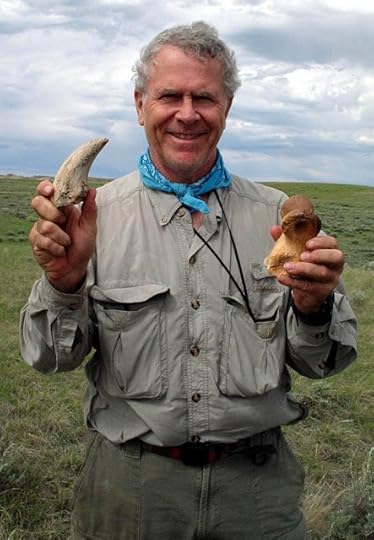 One of the best days in my life, the day I found the H-Rex. "Homer, you did it. I'm a little speechless." - Dr. Jack Horner
One of the best days in my life, the day I found the H-Rex. "Homer, you did it. I'm a little speechless." - Dr. Jack Horner
 Juvenile T.rex claw. "Where's the rest of it?" - Jack Horner
Juvenile T.rex claw. "Where's the rest of it?" - Jack Horner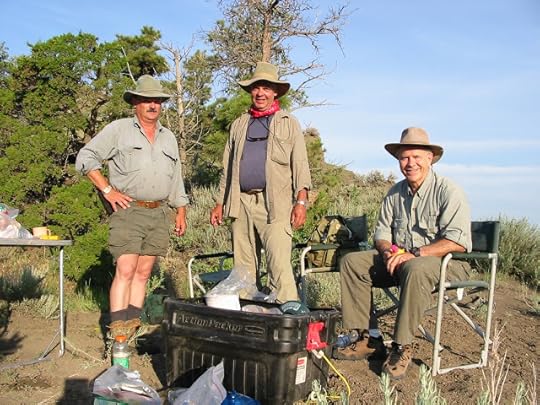 Frank, Bill H., and me the day after the great storm. Yes, our boat was sunk, and yes, we lost our food, and, yes, we lost our beer, and yes, we almost died, and yes, we went dino hunting the next day.
Frank, Bill H., and me the day after the great storm. Yes, our boat was sunk, and yes, we lost our food, and, yes, we lost our beer, and yes, we almost died, and yes, we went dino hunting the next day.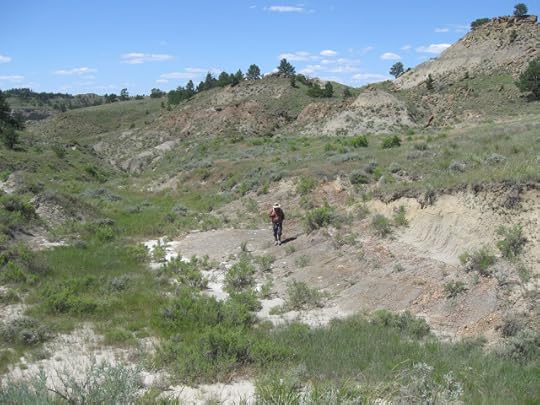 Frank prospecting
Frank prospecting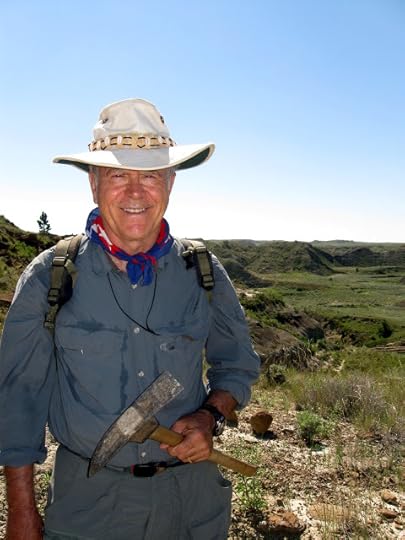 On the scout for the juvie T
On the scout for the juvie T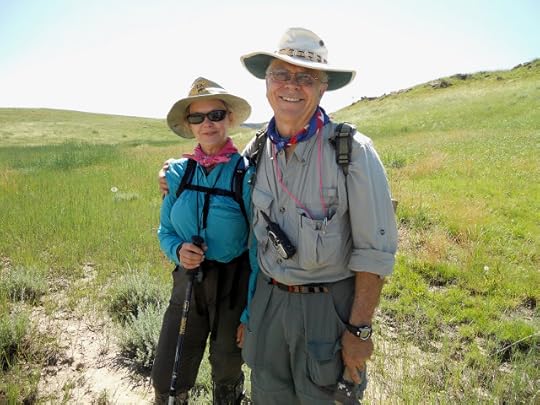 Linda finally joined us for a summer. She did great.
Linda finally joined us for a summer. She did great. Frank and I confer on a bone coming out of the hill
Frank and I confer on a bone coming out of the hill Linda prospecting
Linda prospecting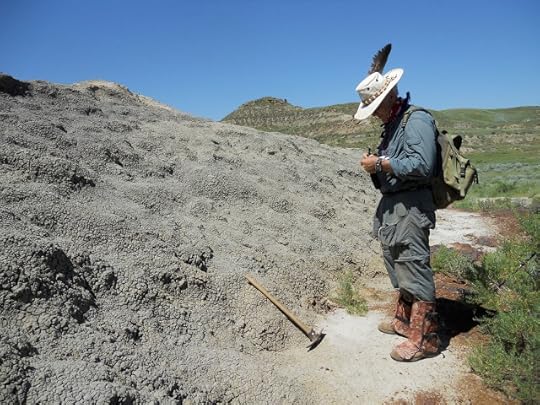 Noting a small find
Noting a small find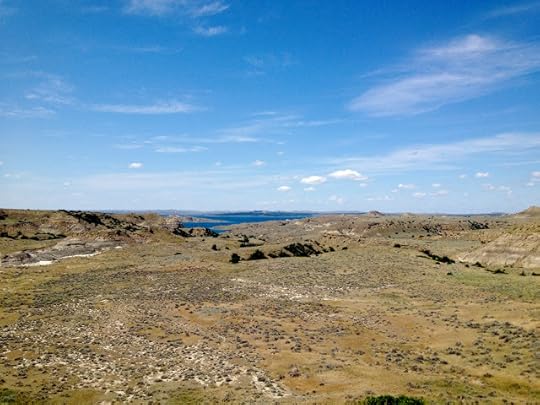 My view at lunch. Fort Peck Reservoir in distance
My view at lunch. Fort Peck Reservoir in distance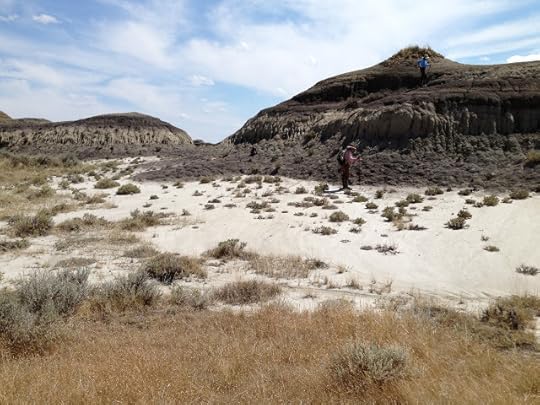 An ancient beach. Mud flow behind it was always a great place to find dinos.
An ancient beach. Mud flow behind it was always a great place to find dinos. The famous "Homer's Nose" which changed the debate on the nature of Triceratops.
The famous "Homer's Nose" which changed the debate on the nature of Triceratops.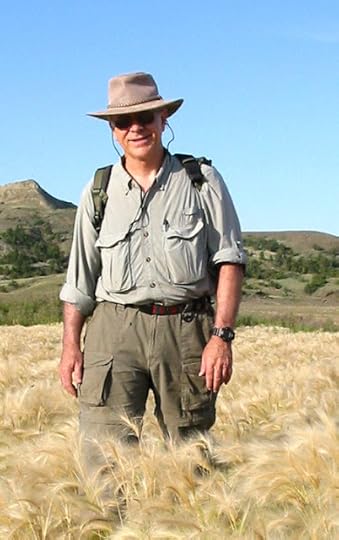 Ready for a day of prospecting in a sea of grass.
Ready for a day of prospecting in a sea of grass.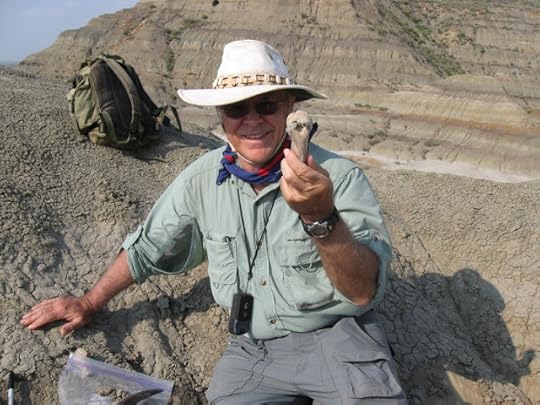 A nice theropod bone. There may be the rest of the animal just below.
A nice theropod bone. There may be the rest of the animal just below. Linda and me at the "Old Blue Car," a landmark for dinosaur hunters.
Linda and me at the "Old Blue Car," a landmark for dinosaur hunters.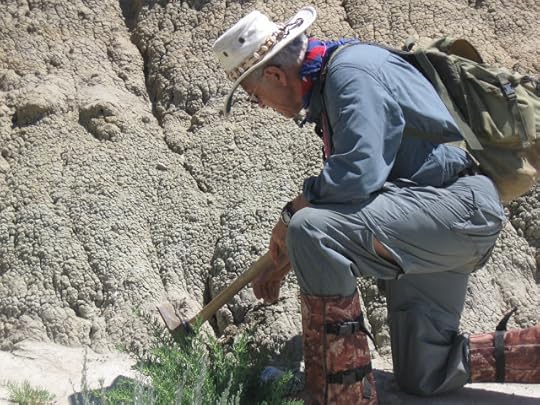 Making a judgement on a find
Making a judgement on a find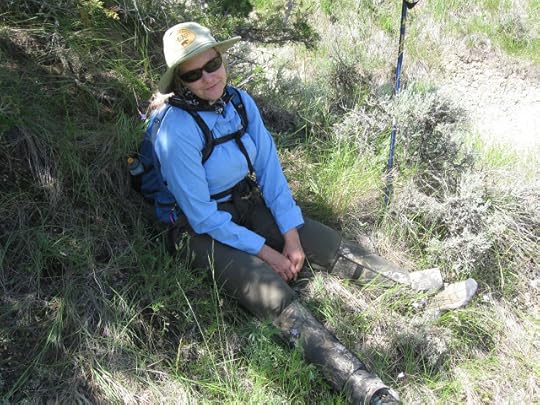 Linda after a hard day on the hunt.
Linda after a hard day on the hunt.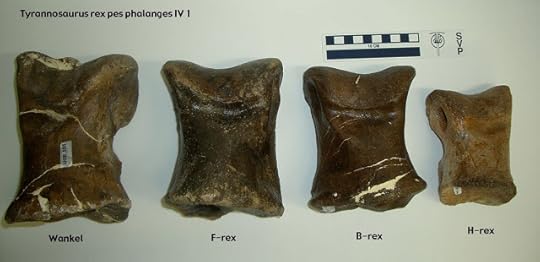 H-Rex metatarsal compared to other famous T.rexes. The H-Rex helped Dr. Horner determine how T.rexes lived.
H-Rex metatarsal compared to other famous T.rexes. The H-Rex helped Dr. Horner determine how T.rexes lived. Here I found evidence of an Ankylosaur. I'm still looking for it.
Here I found evidence of an Ankylosaur. I'm still looking for it.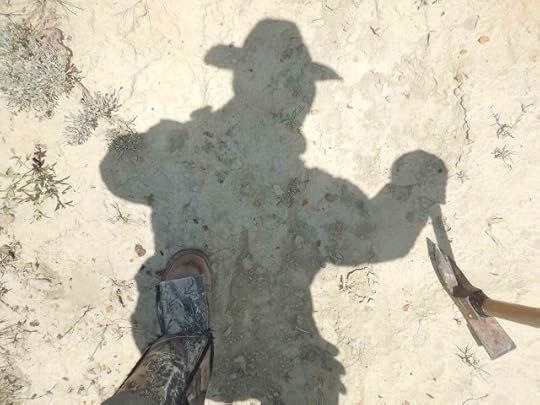 A shadow in a very hot sun
A shadow in a very hot sunJuly 25, 2019
My Open Letter to NASA Managers Who Can't Say "Moon" without "Mars" in the Same Sentence: Please stop it.

Dear NASA Managers who can't say "moon" without "Mars in the same sentence:
I love you, I really do but please stop it.
Although you may think that everybody agrees with you that Artemis is just a touch and go on the path to Mars, let me assure you that it isn't with me and many, many others in the space community. We've worked hard for years to get us to the point where maybe we're finally going back to the moon.
We've even got a Vice President who is behind NASA, who wants you to go to the moon and build something permanent there, and who has stuck out his neck for you. For years, lots of us have been working in every way we can - me with my books and my other writings - to get someone in the Executive Branch who is really serious about going back to the moon, not in a sprint with flags and all that but for a purpose that's good enough to keep us there.
But now I fear you're about to totally screw it up mainly because of where your heads are on this moon and Mars thing.
So, with great respect to all of you who toil every day on the pathways to space, let me be clear: Every time you folks at NASA tack "and then we're headed to Mars" onto your comments about going back to the moon, you diminish the moon as a destination whether you realize it or not. As such, you are totally confusing everybody, especially young people. Common sense says you're not going to Mars because you have no orders to go there and the technology not only doesn't exist, there are no plans to make it exist.
So, dear NASA folks, if we're going to get young people excited about space, trust me on this: The moon is exciting enough and I'm going to tell you why .
But first let's consider Mars. Not the Mars that seems to be the place you want to go. The real Mars.
The Mars I think you imagine is actually a fantasy, a wonderful fantasy, but still very much one that exists mostly because of the wistful dreams started by Percival Lowell a century ago when he wrote fanciful books about Mars as if they were factual which was picked up by H.G. Wells and Edgar Rice Burroughs and a thousand other writers since who've filled our heads with unrealistic concepts of what Mars is really like.
NASA, however, must not promote fantasies. It's all right for Elon and others to believe in the fantasy and work toward it - it's their money and their time and otherwise they're doing great work - but you have to take an actual, hardheaded look at the fourth rock out from the sun because you're spending the people's money.
So here we go: Mars is no "fixer upper" as Elon calls it. In fact, Mars is a fearsome place, a dwarf planet, only one third the size of the Earth and but twice the size of our moon.
Mars has no atmosphere to speak of and what it has cannot be breathed. It has virtually no air pressure so it might as well be a vacuum for planning purposes in terms of keeping people alive.
Mars is horrifically cold, averaging 81 degrees below zero, meaning that only a slight failure in an astronaut's suit heating system will cause frostbite perhaps requiring amputation. Look at the climbers of Mount Everest and how they often have to have toes, fingers, and noses cut off to avoid gangrene after being frostbitten in, compared to Mars, relatively benign conditions. Unless suit technology is revolutionized with some sort of nuclear backpack providing heat and air, astronauts on Mars are doomed to frostbite and, without tons of heavy compressors and filters and tanks, a thing called asphyxiation.
Well, you say, that didn't happen on the moon during Apollo. Well, I reply, the astronauts were only there temporarily and quickly headed back to Earth. Your Mars fantasy is to go there and stay for months and possibly years on end without help from anybody. You've got a totally different situation to deal with.
But let's keep going.
Mars has no magnetic field like Earth and therefore radiation and cosmic rays cascade down on its surface. The only instrument we've put there to measure it registered so much radiation in a solar flare that it knocked out the instrument but not before it let us know any Earthian mammal would have died.
Mars soil is deadly to Earthian plant-life. Without leaching out the perchlorates and adding massive amounts of water and fertilizer, nothing can be grown in it. This means continuous food supplies have to be sent out over an average of 140,000,000 miles more or less constantly. Are you prepared for that? Did you plan on farming? Astronauts performing stoop labor isn't a likely image even if you carried all that fertilizer and were able to wash the soil with Mars water. Consider what that's going to take. It's a massive undertaking and just to keep a few people fed.
All this means astronauts on Mars will have to live underground or beneath a pile of rubble in some kind of habitats and will require constant supplements from Earth. We decidedly do not know how to build such self-sustained habitats! Only once has it been tried and that was the Biosphere II attempt in Arizona which failed.
And should we solve all that and our astronauts are able to live inside their man-made caves, they will only be able to make brief stints outside in suits while getting irradiated in the process, risking frostbite, and hoping their air holds out and they don't starve or die of thirst. Some fun.
But before even all that, there's the voyage just to get there. Unfortunately, NASA doesn't have anything even on the drawing boards that could remotely carry astronauts to Mars and land them there. Your Orion capsule is woefully inadequate for anything more than a few weeks. Essentially, you've got to build something roomy like the International Space Station and set sail all its massiveness to Mars if you've any hope of keeping a crew healthy and even then, it's going to be touch and go because, you know, people get sick.
Ten months one way (when the planets line up meaning sometimes it'll take considerably longer) through irradiated space in weightless conditions means your astronauts will arrive with decreased muscle mass, brittle bones, damaged eyeballs and perhaps brains and then you expect them to then perform like the Apollo astronauts? Unlikely. It would be like putting 80 year olds atop Mount Everest and telling them to get out and go to work. Unhappily, you're going to need a complete pharmacy and surgery to get anybody that far out, especially using chemical rockets.
So you say you'll just build bigger better rocket engines? Great. Do it. But even thermal nuclear engines would only cut that trip in half and even if it cut it to a third, you don't have such engines and it's going to be awhile to get them and you don't need them for the moon. So where are they in the pipeline? Some of your folks are doing great work on them but realistically, such engines are many years away from flying with humans aboard. You'll need to first test them with robotic spacecraft many times. What are we looking at? Decades? Probably.
And just consider - please - what it would take to design and build all this hardware both as ships and landers and habitats and then build the simulators and train the ground personnel and then keep this huge marching army trained, salaried, and content. Nowhere have I seen the slightest work on your part to identify this horde of people working on the ground you're going to need just so a few astronauts can go to Mars. Maybe Elon can go with a skeleton crew on the ground and risk himself and his employees and volunteers but, dear NASA, you are a federal agency who answers to the people. You've got to go in force with more than a reasonable chance of success with a powerful reason to go in the first place or not go at all. That's just the way it is.
For NASA to send humans to Mars, then, isn't going to be anything like Apollo. It's going to be more like D-Day and will require an effort that essentially mobilizes the nation to make something happen that really doesn't have to for national survival and forever be an economic drain. How long do you think it will be supported?
At some point, when you really sit down and see what it will take to send humans to Mars, you quickly begin to appreciate that NASA could send a thousand, nay ten thousand robots there to roam, dig, root through, drill within, and fly over that planet and see exactly what's there. Also, eventually artificial intelligence, possibly even in the shape of humans if that is desired, make so much more sense as we can crawl inside their heads and see exactly what they see and what they feel without having to deal with the frailties of human beings.
And, as a trainer of many astronauts, I have to tell you that unless our technology changes immensely, you are asking far too much from normal human beings to send them on such missions to Mars with the equipment we can realistically acquire over these next several decades.
Now, with Mars realistically described, let's take a look at your concept of the moon. A lot of you NASA managers think it's just a practice ground but I'm sorry, that's so Old Space. There is the moon and then there is the moon.
The moon I fear you are looking at is the moon of Apollo which was considered a cold, dead, dry, and essentially uninteresting place and therefore that's why the missions were cancelled so you'd better just bounce off it and keep going. The real moon, however, is actually much different than we thought it was fifty years ago.
We have learned so much about the moon since Apollo. The great news is it's wet. It may very well hold signs of life that either had an origin on the moon or, more likely, was sent from Earth during various primordial collisions or came in from outer space aboard comets. This should make the moon fascinating to scientists and philosophers alike.
Consider this: We haven't looked at with a microscope a single drop of water from OFF our world. That's pretty interesting when you consider that we've never looked at a single drop of water from ON our world that wasn't filled with life or evidence of life. Just one drop of moon water - life or no life - is going to tell us an enormous amount on who we are and where we came from and what's likely out there waiting for us.
Besides water and its uses and perhaps evidence of life or past life, the moon is loaded with stuff we can use and I'm sure you know the list. So let's go get it.
Unlike Mars which will be an economic drain where only the bravest, strongest, and mostly single and divorced astronauts can go who are willing to shorten their lives considerably in order to visit a dead little planet, the moon, because it is so near and interesting and filled with resources, can be a place where actual, real, and normal people can go, where minerals are acquired for the Earth that will supplement our economy, and where people can work and make some money and create a space economy. And lots of fantastic science can be done, too.
So here's what I believe and think you should, too: NASA's job right at this moment is to put an anchor down on the moon that will allow everyone, private or governmental, to follow by using it as a safe haven before heading out to the Lunar Outback to prospect. To do that, you're looking at decades of work - good wonderful work - that will see plumbers, miners, electricians, construction workers, and so forth actually living on the moon. Isn't that enough? I think so.
In summary, dear NASA managers, the moon is NOT a practice area. It is our eighth continent and I believe you have the responsibility to get us back there and set up shop so the rest of us can follow. Now, let's get going and, for goodness sake, unless you're talking about robotic missions, please stop talking about Mars!
All the best,
Homer
PS - Once our moon-Earth economy is up and running, and we find the right planet around the right star... well, I'll be there for you. That will be a worthy objective. Let's do it. Let's go.
July 21, 2019
Why go to the moon? Simple. To Gather Resources We Need
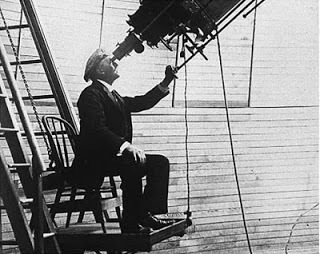 Percival Lowell, billionaire, astronomer, and kinda crazy
Percival Lowell, billionaire, astronomer, and kinda crazyAfter that, I examined what it would actually take to send humans to Mars and my belief that NASA will never attempt it nor will anyone else who's reasonable because this tiny little planet isn't worth the blood, time, or treasure to send humans there when robotic and artificial intelligence is available to thoroughly explore it and get back all the answers it might hold. https://homerhickamblog.blogspot.com/2019/07/mars-is-not-for-humans-not-now-and.html
 Earth
Earth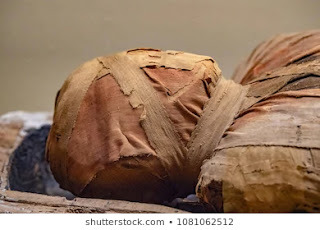 Mars
Mars Artificial Intelligence (AI) Buffy
Artificial Intelligence (AI) BuffyBut this isn't true for Luna, our moon. It's different. People not only can go there, they should go because we need their intelligence, their labor, and their sweat to gather important resources for the world.
My opinion is undoubtedly colored by the unique place I'm from, a town called Coalwood in a state called West Virginia in a place called Appalachia where it's difficult to get there, difficult to live there, but has resources that must be shipped elsewhere in order to keep our civilization humming along.
 That's me, third from the right kneeling. Just us 9th grade boys
That's me, third from the right kneeling. Just us 9th grade boysafter visiting the mine where our dads worked. They made money in a dangerous profession but
raised their families, educated their kids, and sent us off to the unsuspecting
world where we did pretty darn well. Our dads were just like what miners on the moon will be like, good, robust, hearty, and daggone smart.
In other words, I'm from a place something like the moon.
West Virginians came to the mountain state in the early 20th Century attracted by the coal mining industry. It wasn't that they necessarily liked mining coal. They came so as to make money and have a place where they could raise their families. The work they did was nasty and dangerous but they still did it and did it as long as they could. After awhile, it became their way of life and they fell in love with the mountains, hills, and valleys of the rugged land.
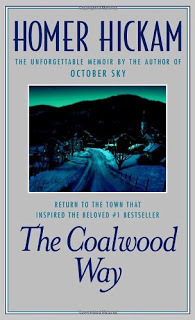 One of my memoirs about life in Coalwood.
One of my memoirs about life in Coalwood.
It was a New York Times
best-seller.
Their way of life is the way I think life on the moon could and should evolve.
A few years back, I wrote about the descendants of West Virginians in Crescent , the second novel in my "Crater" trilogy. In the 22nd Century, Crater, a young Helium-3 miner, and Crescent, a genetically modified female, meet a group on the moon who are fleeing from Earth because their land has been stolen. It turns out they are from an area in the former United States known as Appalachia which has been forcibly depopulated for socio-economic reasons. This is not too farfetched as much of the West Virginia county and the town of Coalwood where I grew up has been depopulated, the people forced to go elsewhere to find jobs. I am one of those ex-pats so I can relate to the group that Crater and Crescent agree to lead to a far place on the moon, a mining town called Endless Dust which is laid out somewhat like Coalwood.
Recently, I told Senator Ted Cruz and his Aviation and Space Subcommittee that what I want out of the space program is "Coalwood on the moon" and that I don't care two cents about who the next professional astronaut is who goes there. What I care about is opening a place where real people - plumbers, electricians, miners, construction workers, and other so-called blue collar workers - can go work, make money, and raise their families just like in the Coalwood where I grew up. Go here to see exactly what I said:
https://www.youtube.com/watch?v=xRbCkFYZpWk&feature=youtu.be&fbclid=IwAR1v9ls4FT3cJGXFBGYJu4XJ2IBbCa-ei1DAHFV-aN_a7fnT9uStwxCK6bg
The moon I describe in Crater, Crescent, and The Lunar Rescue Company is a place where there are many Coalwoods, frontier mining towns populated by a rugged people made even tougher and stronger by the land in which they live.
 My "Crater" series of novels (aka Helium-3 series).
My "Crater" series of novels (aka Helium-3 series).
So how does that happen? How does the moon go from being an exotic fantastic locale where only brave astronauts dare to go to a place of work for folks like those who raised their families in Coalwood? And why would the taxpayers of the United States and our partners and allies ever want to shell out even a dime to make that happen?
It is because the moon qualifies as a reasonable place for the world to expand and gather resources.
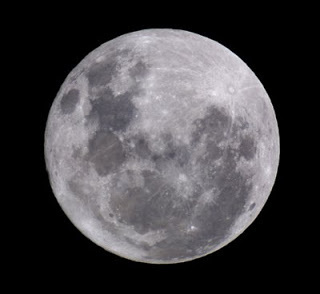 Hi there. I'm Luna, your neighbor. I've got lots of good stuff for you
Hi there. I'm Luna, your neighbor. I've got lots of good stuff for youif you'll come and get it.
And what are those resources on the moon that the people of lunar Coalwoods will gather for us and send back? I'll give you the usual list: Platinum, Helium, Helium-3, Thorium, etc. etc. and so forth but remember beneath every crater is the shattered remains of an asteroid. There's likely gold in them thar lunar hills and a lot else, too.
 Here's another best-seller I wrote. Vice President Pence
Here's another best-seller I wrote. Vice President Pencesaid it was one of his favorite books. It's a little outdated but
still has some great stuff in it about why we need to go back.
And it's got adventure. And thrills. And great characters.
And sex in space, too (not that it has anything to do with anything else).
As to the "how," it's also pretty simple. We as a nation have done the flags and footprints on the moon thing with Apollo Now, 50 years later, we need an anchoring base on the moon from which other entities, whether governmental or private, can come to, outfit themselves and then set across the lunar plains, valleys, rilles, and hills to explore and then build their roads and towns and start working and making money and raising their families and sending resources back to a needy Earth.
That's it. That's all our federal government has to do. Just build an anchor up there, one staging area and then hold onto it long enough for all others to follow and build up a lunar civilization based on gathering resources.
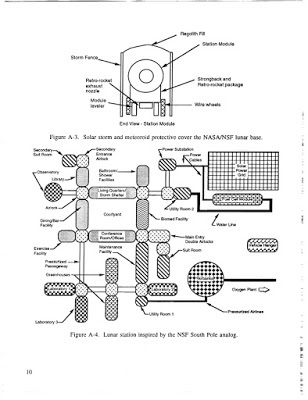 My clever little moon anchor as described in my 1993 (!) study for NASA
My clever little moon anchor as described in my 1993 (!) study for NASA
I kind of mapped that anchor out in my 1993 study which I cleverly disguised as a comparison with the South Pole Station that can be seen here: https://homerhickamblog.blogspot.com/2019/03/1993-study-of-moon-laboratory-by-homer.html
Will Americans come around to my vision?
We shall see.
- - Homer Hickam
Why go to the moon? Simple. To keep civilization as we know it from collapsing. Is that too much to ask?
 Percival Lowell, billionaire, astronomer, and kinda crazy
Percival Lowell, billionaire, astronomer, and kinda crazyAfter that, I examined what it would actually take to send humans to Mars and my belief that NASA will not ever attempt it nor will anyone else who's reasonable because this tiny little planet isn't worth the blood, time, or treasure to send humans there when robotic and artificial intelligence is available to thoroughly explore it and get back all the answers it might hold. https://homerhickamblog.blogspot.com/2019/07/mars-is-not-for-humans-not-now-and.html
 Earth
Earth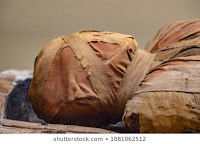 Mars
Mars Artificial Intelligence (AI) Buffy
Artificial Intelligence (AI) BuffyBut this isn't true for Luna, our moon. It's different. People not only can go there, they should go because we need their intelligence, their labor, and their sweat to pretty much save the world. This concept, however, seems to be beyond the capability of some folks to understand or explain while to me, it's simple.
But maybe that's because of the unique place I'm from, a town called Coalwood in a state called West Virginia in a place called Appalachia where it's difficult to get there, difficult to live there, but has resources that must be shipped elsewhere in order to keep our civilization humming along.
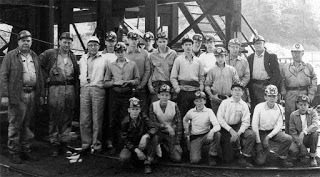 That's me, third from the right kneeling. Just us 9th grade boys
That's me, third from the right kneeling. Just us 9th grade boysafter visiting the mine where our dads worked
In other words, I'm from a place something like the moon.
West Virginians came to the mountain state in the early 20th Century attracted by the coal mining industry. It wasn't that they necessarily liked mining coal. They came so as to make money and have a place where they could raise their families. The work they did was nasty and dangerous but they still did it and did it as long as they could. After awhile, it became their way of life and they fell in love with the mountains, hills, and valleys of the rugged land.
 One of my memoirs about life in Coalwood
One of my memoirs about life in Coalwood
Their way of life is the way I think life on the moon could and should evolve.
A few years back, I wrote about the descendants of West Virginians in Crescent , the second novel in my "Crater" trilogy. In the 22nd Century, Crater, a young Helium-3 miner, and Crescent, a genetically modified female, meet a group on the moon who are fleeing from Earth because their land has been stolen. It turns out they are from an area in the former United States known as Appalachia which has been forcibly depopulated for socio-economic reasons. This is not too farfetched as much of the West Virginia county and the town of Coalwood where I grew up has been depopulated, the people forced to go elsewhere to find jobs. I am one of those ex-pats so I can relate to the group that Crater and Crescent agree to lead to a far place on the moon, a mining town called Endless Dust which is laid out somewhat like Coalwood.
Recently, I told Senator Ted Cruz and his Aviation and Space Subcommittee that what I want out of the space program is "Coalwood on the moon" and that I don't care two cents about who the next professional astronaut is who goes there. What I care about is opening a place where real people - plumbers, electricians, miners, construction workers, and other so-called blue collar workers - can go work, make money, and raise their families just like in the Coalwood where I grew up. Go here to see exactly what I said:
https://archive.org/details/CSPAN3_20190710_100600_Senate_Commerce_Subcommittee_on_NASA_Exploration
The moon I describe in Crater, Crescent, and The Lunar Rescue Company is a place where there are many Coalwoods, frontier mining towns populated by a rugged people made even tougher and stronger by the land in which they live.
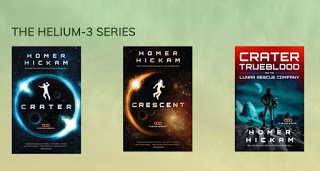 My "Crater" series of novels (aka Helium-3 series)
My "Crater" series of novels (aka Helium-3 series)
So how does that happen? How does the moon go from being an exotic fantastic locale where only brave astronauts dare to go to a place of work for folks like those who raised their families in Coalwood? And why would the taxpayers of the United States and our partners and allies ever want to shell out even a dime to make that happen?
Let's deal with the "why" which might be controversial - so be it - but the way I see things.
Earthian civilization in general is in a precarious position. Worldwide, from my study of what we're up to these days, it seems we have settled on a model for prosperity that has always worked for awhile, sometimes a good long while, but always inevitably contracts and collapses.
It is the model that Rome, both the Republic and the Empire, used which required gobbling up resources while expanding. When expansion stopped, it didn't equal stability for Rome. It meant contraction which meant dwindling resources which meant ultimate collapse.
 Hi there, how ya doin'?
Hi there, how ya doin'?Good. Not starving and literate and ready to learn new stuff.
But we got slaves which ain't right.
I know. Maybe we'll get better.
Maybe, if we don't choke. You know, collapse and stuff. In the present situation across the world, such collapse of our economic model (so-called Communist and Socialist states essentially follow the same model although they claim not to) would likely mean exactly what happened in Europe after Rome went away, a long series of violent wars and rampant diseases. In modern times, that would be made all the worse by the loosing of nuclear weapons across the planet by zealots of all stripes.
Rome, for all its many faults, brought stability and the chance to make things better through the expansion of scientific knowledge and philosophy. Its collapse brought mostly misery for a good long while to everybody so we really don't want that to happen again if we can avoid it.
 We choked.
If we can't expand on Earth, the heavens come into play and there is only one place "up there" that qualifies as a reasonable place for the world to expand and gather resources.
We choked.
If we can't expand on Earth, the heavens come into play and there is only one place "up there" that qualifies as a reasonable place for the world to expand and gather resources.Our moon.
So the "why" becomes simply this: We need to gather resources from the moon because if we don't, there's a good chance civilization as we know it will crumble. The stakes are that dire.
And what are those resources on the moon that the people of lunar Coalwoods will gather for us and send back? Well, what were the resources in the lands of the Louisiana Purchase before we sent Lewis and Clark out to discover them? We didn't know but we had faith there was plenty there and our faith was not misplaced but I'll give you the usual list: Platinum, Helium, Helium-3, Thorium, etc. etc. and so forth but remember beneath every crater is the shattered remains of an asteroid. There's likely gold in them thar lunar hills and a lot else, too.
As to the "how," it's also pretty simple. We as a nation - or perhaps as a civilization - need an anchoring base on the moon from which other entities, whether governmental or private, can come to, outfit and gird themselves, and then set across the lunar plains, valleys, rilles, and hills to explore and then build their roads and towns and start working and making money and raising their families and sending resources back to a needy Earth.
That's it. That's all our federal government has to do. Just build an anchor up there, one staging area and then hold onto it long enough for all others to follow and build up a lunar civilization based on gathering resources.
 My clever little moon anchor as described in my 1993 (!) study for NASA
My clever little moon anchor as described in my 1993 (!) study for NASA
I kind of mapped that anchor out in my 1993 study which I cleverly disguised as a comparison with the South Pole Station that can be seen here: https://homerhickamblog.blogspot.com/2019/03/1993-study-of-moon-laboratory-by-homer.html
Building that anchor's not too much to save the world from centuries of pain and poverty, is it?
Is it?
We shall see.



